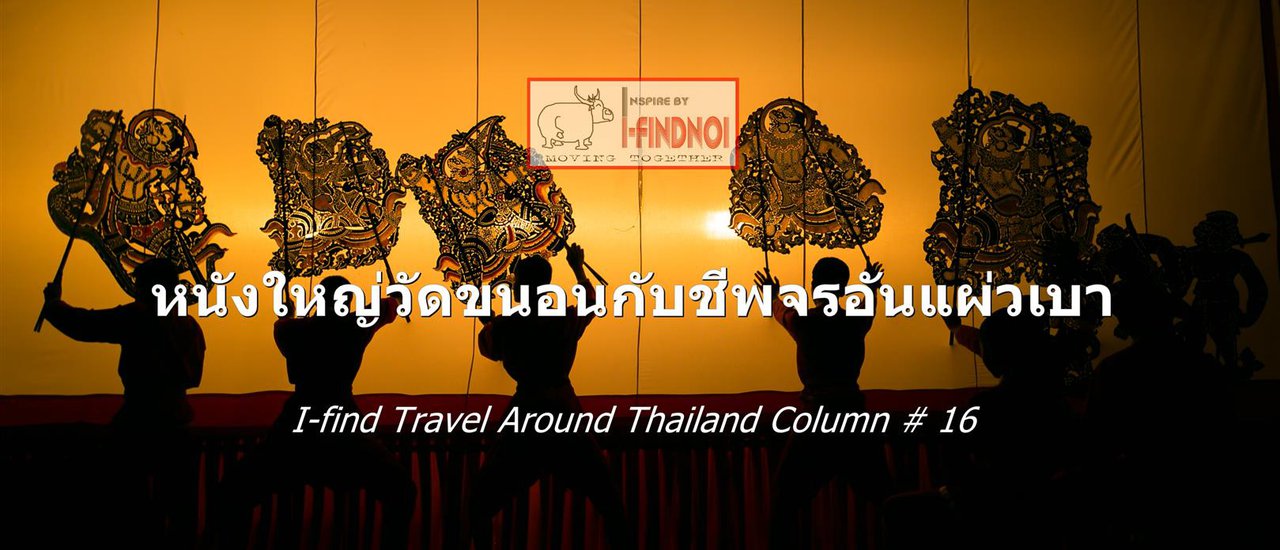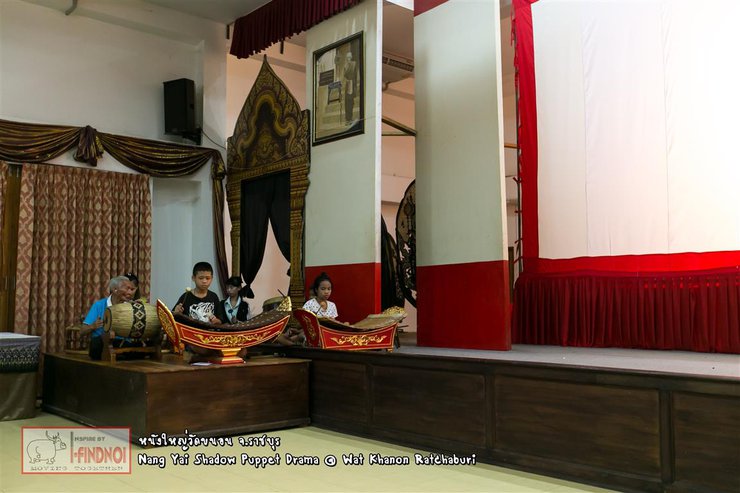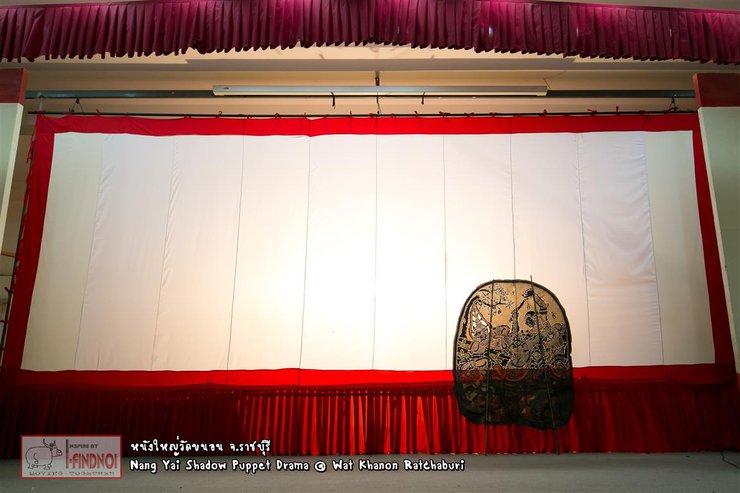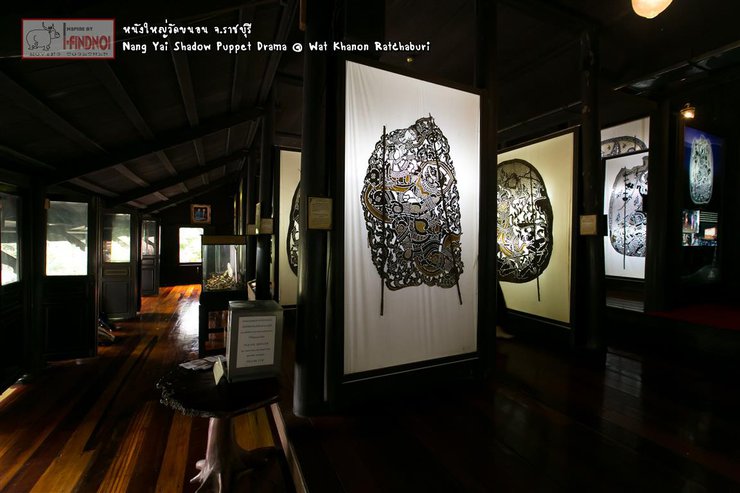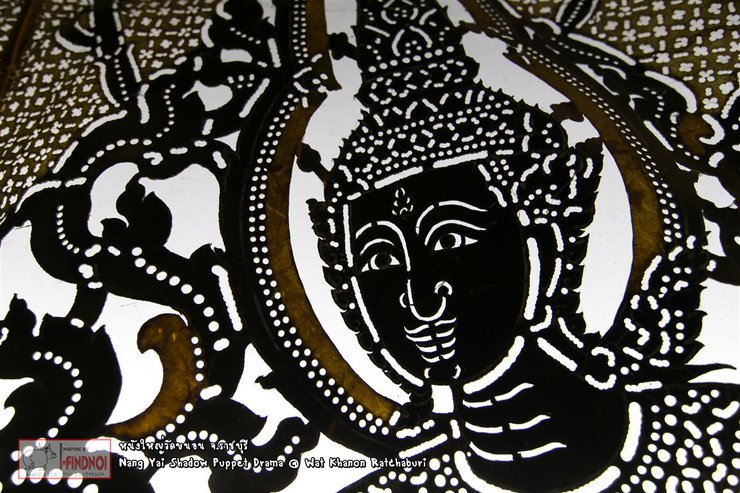
"Nang Yai"
is a high art form of Thailand. It is said to have existed since the Sukhothai period.
However, clear evidence of its existence only appeared during the Ayutthaya period, when Nang Yai was used as royal entertainment.
Later, during the Rattanakosin period, it became popular among the general public and was the most popular form of entertainment at that time.
However, during the reign of King Rama VI, the introduction of Khon performances led to a decline in the popularity of Nang Yai.
Moreover, when the country entered World War II, Nang Yai was abandoned and gradually disappeared from Thai society.

Few young people today are familiar with shadow puppetry, as evidenced by a recent trip my workplace organized to Ratchaburi province.
I suggested visiting the shadow puppet performance at Wat Khanon in Photharam district, Ratchaburi province,
one of the few remaining places in Thailand that still preserves this art form.
Unlike museum exhibits, the shadow puppetry here is not merely a static display; it is a living tradition.
Performances are held every week, yet surprisingly, everyone asked in unison,
"What is shadow puppetry?"


'Nang Yai' is a shadow puppet show similar to Nang Talung, but the puppets are larger.
The puppets are made of cowhide, which is cut and carved into the characters of the story. The most popular story performed is the Ramayana.
During the performance, the puppeteers stand in front of the screen, allowing the audience to see both the puppets and the puppeteers' movements.
This is different from Nang Talung, where only the shadows of the puppets are visible behind the screen.
The story is narrated by a narrator and dialogue is used to advance the plot.
A piphat ensemble provides musical accompaniment, setting the pace and conveying emotions to the audience. Nang Yai is considered a high art form in Thailand, combining dance, speech, music, literature, and craftsmanship.

Out of nearly 20 members, only 4 people, including myself, went to the cinema with me.
The 3 friends who came didn't know how much they wanted to go or if they had to go because they had to ride with me!
On the surface, how can ancient entertainment compete with the exciting entertainment of today?
It may seem boring to modern people, but if you try to get to know it, try to experience it,
We will see the valuable national art and culture that is worth preserving.


We arrived at Wat Khanon about 15 minutes before the show. The atmosphere was quiet and deserted, with only one or two cars parked.
I led my friends straight to the theater building before pushing the door open. I saw rows of seats lined up from the door to the stage.
But they were empty seats with no sign of people.

A white screen with a red border, resembling a movie screen, is erected on the stage, with a large puppet displayed prominently.
On the left side of the stage, a Thai musical ensemble is set up, with children in casual attire playfully interacting.
Unsure, I approached and inquired if there was a performance scheduled for the day.
The young child responded affirmatively, but it was nearing showtime, and aside from the four of us, there was no one else present!

At ten o'clock, the musicians took their places. They were a group of children, led by an elderly man.
Later, we learned that the man was Kru Sutep Nim-on, a teacher who trained the piphat ensemble at Wat Khanon.

The mournful melody of Thai music played by young musicians filled the air, captivating the VIP guests seated in the front row.
The music evoked a profound sense of melancholy, not merely due to its tune, but rather from the deeper contemplation of these young performers' future.
As they mature and encounter new social circles, will they continue to embrace and perform Thai music? Will they remain dedicated to preserving this national art form?
Society, including their parents, may perceive this pursuit as lacking long-term stability and financial security. Moreover, without an audience, their performances would lose their significance.
It would be a tragedy if this centuries-old heritage, passed down through generations, were to vanish in our time.
Fortunately, as the music continued, more audience members gradually arrived and took their seats.
The resonant chanting of the actors in Pali, a traditional language used in religious ceremonies, echoed from backstage, casting a spell of silence over the entire theater.
Then, the young male presenter emerged, clad in a red loincloth, but with an appearance that seemed incongruous.
He sported a mustache, a trendy side-shaved haircut, and earrings, resembling a rebellious teenager. "Oh no, Thai culture!" I thought to myself.

After listening to the speaker's explanation of the history of shadow puppetry, from the puppet making, the script, the music used,
to the two young actors demonstrating the puppet movements to educate the audience before the performance began,
I must apologize for my initial judgment based on appearance. The speaker's presentation made me realize the immense value
and the tremendous effort involved in creating shadow puppetry.

The performance began with an apology that turned into a heartfelt plea for forgiveness. The powerful and captivating voice of the narrator conveyed the emotions of the characters with remarkable depth, leaving the audience wondering how anyone could memorize such lengthy lines.
The puppeteers, no less skilled than the actors, manipulated the puppets with grace and precision, their every step and gesture perfectly synchronized with the accompanying music. The performance captivated the audience for a full hour, leaving them thoroughly entertained and immersed in the story.




Tears welled up in my eyes after the performance. When I looked back, the entire theater was not filled with just four audience members,
but with around 30 people, including a group of foreigners. Although it was not a large number,
it was enough to move me that Thai art and culture, which is on the verge of fading away, has not been forgotten.
There are still people who see its value, who are still breathing life into it.
The pulse of shadow puppetry will continue to beat as long as Thai people help preserve it.


The Route to Wat Khanon
From Bangkok, take Borommaratchachonnani Road (Highway 338) straight to Nakhon Chai Si District, Nakhon Pathom Province.
Approximately 30 kilometers
When you reach the bridge, go straight up and turn right onto Phetkasem Road heading towards Nakhon Pathom city.
Continue straight for about 18 kilometers, you will pass the entrance to Nakhon Pathom city.
Continue straight for another 20 kilometers, you will find a four-way intersection leading to Bang Pae-Photharam District.
Use the road next to the elevated road and turn right onto Highway 3080 following the sign to Photharam District.

Drive approximately 5 kilometers and cross the Mae Klong River bridge. At the three-way intersection, turn right onto Highway 4005.
Continue for another 2.5 kilometers. Wat Khanon will be on your right. The total distance from Bangkok is approximately 84 kilometers.

The shadow puppet show at Wat Khanon is performed every Saturday from 10:00 AM to 11:00 AM and every Sunday from 11:00 AM to 12:00 PM. (Free admission)
The shadow puppet museum is open daily from 8:00 AM to 5:30 PM.

For more articles by Ifind, please visit http://www.bloggang.com/mainblog.php?id=ifind.
I-FINDNOI
Friday, October 4, 2024 3:13 PM

